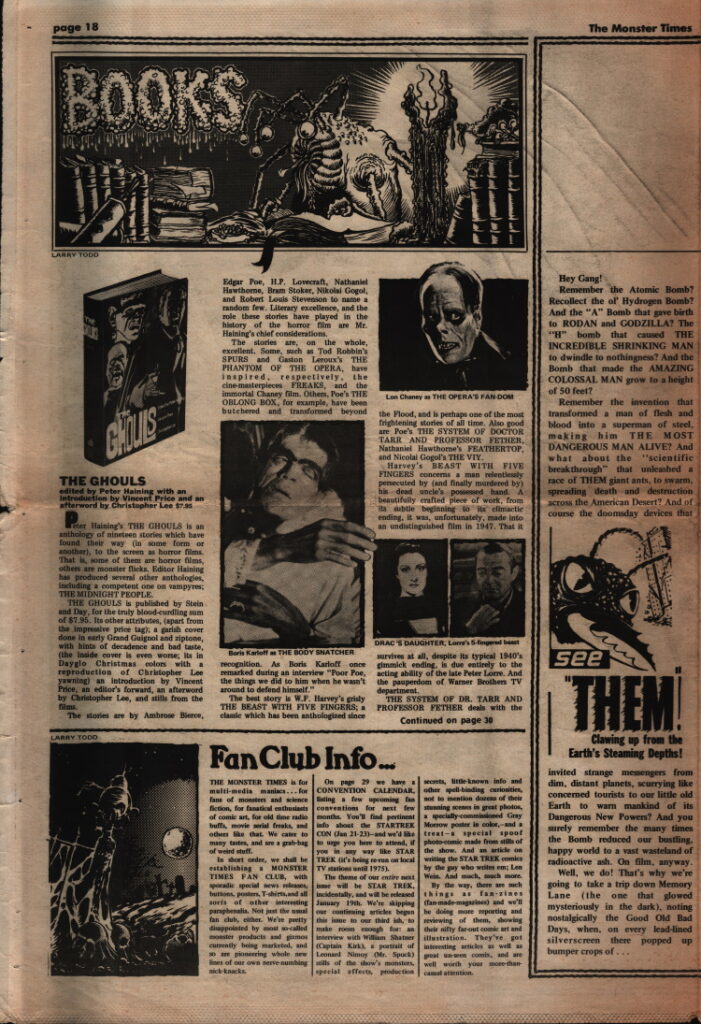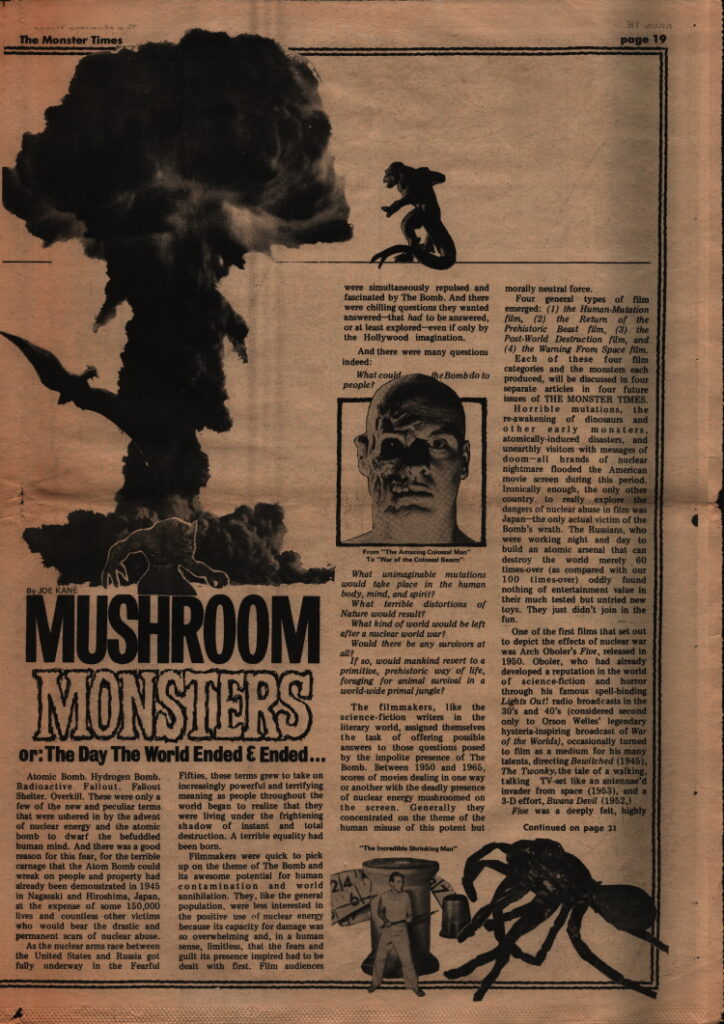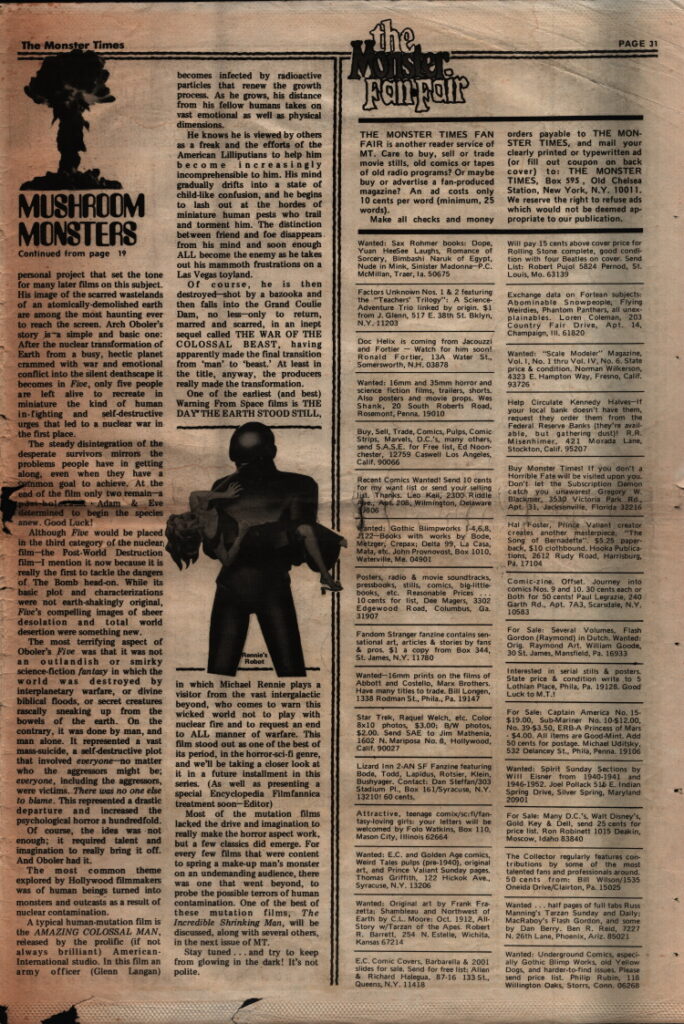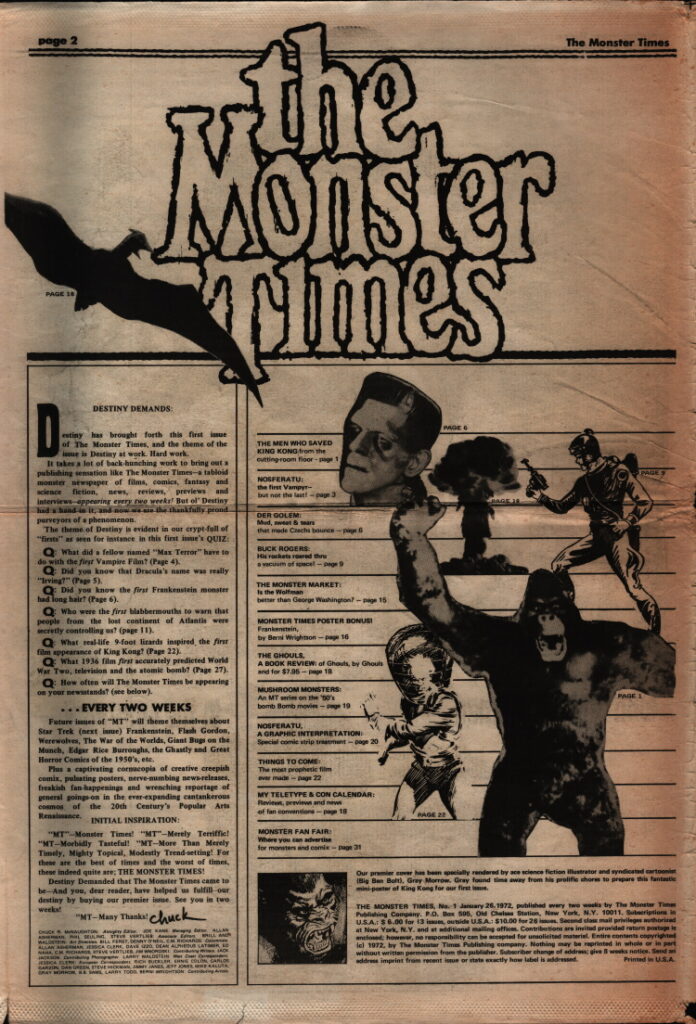OH BOY! STAR TREK! A whole issue dedicated to every aspect of the show! Just one question – Why?
That’s a pretty good question…
Well, this special ish of THE MONSTER TIMES serves a 2-fold purpose – to celebrate the first annual STAR TREK CONVENTION, January 21, 22, 23 at New York’s Statler-Hilton, and secondly, to commemorate the convention’s memory.
HUH?
You see, we figured the STAR TREK CON was such a nifty idea, that we put out this special issue in honor of it. However, as our distribution schedules go, some of you readers will be reading this in your (few) spare moments at the hectic bustling TREK-CON, as this ish is made specially available to you there, whereas the rest of you have purchased your copy after the convention, at your local newsstand.
So this issue is both a special supplement and a memento of the gala occasion, and we have made our coverage so thorough, that those who didn’t attend the con can get the spirit and crazy exuberance of the luna-module-tic affair. So it’ll seem to you you were there (poor souls!).
ANCIENT SECRETS REVEALED:
Doubtless there are many questions about the show you have long wanted answering. Just to be pesky, we’ll ask them again:
Q: Who was STAR TREK’s salt-thriving vampire? page 5.
Q: Who kept hiding Leonard Nimoy‘s bicycle in the studio rafters? page 14
Q: Did you know the first STAR TREK model kit was a real lemon? page 22
Q: What did chopped chicken liver get for one wise Trekkie? page 28
Q: What lunacies will we be presenting two weeks from now? See back cover.
So, for those of you who’ve bought this modestly superb effort at the STAR TREK CON, enjoy the festivities – and maybe drop over by THE MONSTER TIMES’ special table in Spaceway Hucksters’ room, and maybe perhaps subscribe (mercenary, ain’t we!). For those who (sadly) missed the convention (details of it are on page 23), we hope this issue makes up for it, and we hope to see you there next year.
Next issue (2 weeks from now), we return to our regular newspaper programming, with Giant Bugs on the Munch. See you and your napkins then!
“MT-Many Thanks! Chuck
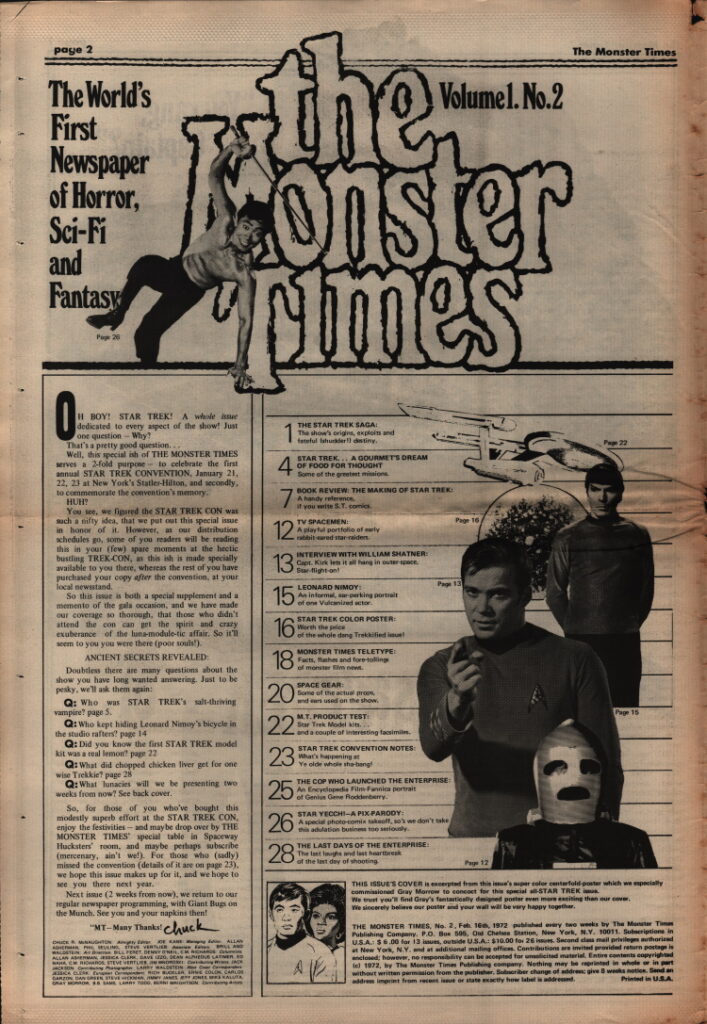
CHUCK R. McNAUGHTON: Almighty Editor. JOE KANE: Managing Editor. ALLAN ASHERMAN, PHIL SEULING, STEVE VERTLIEB: Associate Editors. BRILL AND WALDSTEIN. Art Direction. BILL FERET, DENNY O’NEIL, C.M. RICHARDS: Columnists. ALLAN ASHERMAN, JESSICA CLERK, DAVE IZZO, DEAN ALPHEOUS LATIMER, ED NAHA, C.M. RICHARDS, STEVE VERTLIEB, JIM WNOROSKI: Contributing Writers. JACK JACKSON: Contributing Photographer, LARRY WALDSTEIN: West Coast Correspondent. JESSICA CLERK: European Correspondent. RICH BUCKLER, ERNIE COLON, CARLOS GARZON, DAN GREEN, STEVE HICKMAN, JIMMY JANES, JEFF JONES, MIKE KALUTA, GRAY MORROW, B.B. SAMS, LARRY TODD, BERNIE WRIGHTSON: Contributing Artists.
1 THE STAR TREK SAGA:
The show’s origins, exploits and fateful (shudder!) destiny.
4 STAR TREK… A GOURMET’S DREAM OF FOOD FOR THOUGHT
Some of the greatest missions.
7 BOOK REVIEW: THE MAKING OF STAR TREK:
A handy reference, if you write S.T. comics.
12 TV SPACEMEN:
A playful portfolio of early rabbit-eared star-raiders.
13 INTERVIEW WITH WILLIAM SHATNER:
Capt. Kirk lets it all hang in outer space, Star-flight-on!
15 LEONARD NIMOY:
An informal, ear-perking portrait of one Vulcanized actor.
16 STAR TREK COLOR POSTER:
Worth the price of the whole dang Trekkified issue!
18 MONSTER TIMES TELETYPE:
Facts, flashes and fore-tollings of monster film news.
20 M.T. PRODUCT TEST:
Star Trek Model kits… and a couple of interesting facsimiles.
23 STAR TREK CONVENTION NOTES:
What’s happening at Ye olde whole sha-bang!
25 THE COP WHO LAUNCHED THE ENTERPRISE:
An Encyclopedia Film-Fannica portrait of Genius Gene Roddenberry.
26 STAR YECCH! – A PIX-PARODY:
A special photo-comix takeoff, so’s we don’t take this adulation business to seriously.
28 THE LAST DAYS OF THE ENTERPRISE:
The last laughs and last heartbreak of the last day of shooting.
THIS ISSUE’S COVER is excerpted from this issue’s super color centerfold poster which we especially commissioned Gray Morrow to concoct for this special all-STAR TREK issue. We trust you’ll find Gray’s fantastically designed poster even more exciting than our cover. We sincerely believe our poster and your wall will be very happy together.
THE MONSTER TIMES, No. 2, Feb. 16th, 1972 published every two weeks by The Monster Times Publishing Company. P.O. Box 595, Old Chelsea Station, New York, N.Y. 10011. Subscriptions in U.S.A.: $ 6.00 for 13 issues, outside U.S.A.: $10.00 for 26 issues. Second-class mail privileges authorized at New York, N.Y. and at additional mailing offices. Contributions are invited provided return postage is enclosed; however, no responsibility can be accepted for unsolicited material. Entire contents copyrighted (c) 1972, by The Monster Times Publishing company. Nothing may be reprinted in whole or in part without written permission from the publisher. Subscriber change of address; give 8 weeks notice. Send an address imprint from recent issue or state exactly how label is addressed.
Printed in U.S.A.

